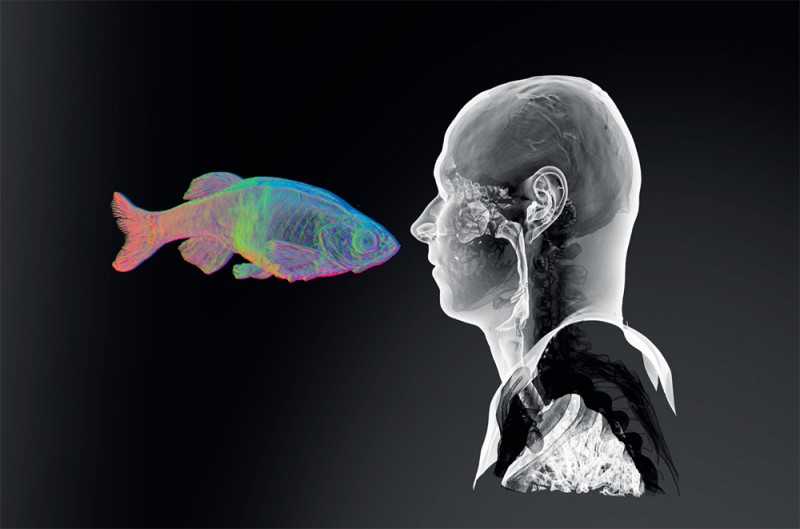Curious Intersections of SciArt

Jean-Sébastien Gauthier, Face to Face, 2017, digital rendering from synchrotron X-ray microtomography of adult zebrafish and CT scan of the artist. All images are excerpts from “Within Measure,” a collaboration with Brian F Eames, PhD. All images courtesy the artist.
Curiosity has had a bad rap through the ages. As a proverb it is the source of feline termination, and in classical myth it blames Pandora for releasing into the world a cornucopia of evils. But for Jean-Sébastien Gauthier, a Saskatoon-based sculptor and video and installation artist, curiosity has opened up exciting possibilities for the intersection of science and art. “If you are curious you recognize your knowledge blind spots and as you learn more, you realize how little you know of something else. That is a driving force for me.”
Gauthier is the artist-in-residence in the Department of Anatomy and Cell Biology at the University of Saskatchewan, where he is working with Dr Brian Eames, a researcher in the College of Medicine whose specialty is how cells turn into bone and cartilage. Together they have access to the only synchrotron in Canada (and one of only 40 in the world). A synchrotron is a particle accelerator that produces such complex and brilliant light that it allows us to see things in new ways. Eames is using it to study zebrafish development; Gauthier is using images of the zebrafish in various stages of embryological development to make aesthetic connections between the animal and the human world.
In Still Life (after Ernst Haeckel) Gauthier uses the presentation methods of the 19th-century German zoologist and illustrator to arrange a collection of embryos and full-sized zebrafish. They are like gossamer drawings, all line and linkage adding up to exquisite forms. What Gauthier’s images make clear is that scientists and artists, especially sculptors, are both interested in morphology because they need to know how things form themselves. Their First Testament would be the Book of Morphogenesis.

Still Life (after Ernst Haeckel), 2017, digital rendering from synchrotron X-ray microtomography of adult zebrafish and zebrafish embryos.
“The key shared element between our two practices is novelty,” says Gauthier, “but with this difference. Scientists want reproducibility of results and I would argue that artists want the opposite. An artist doesn’t really want someone else to make what they make.” What Gauthier has made is unique. In Sample & Hold: self-portrait with model organism in both a 3D printed sculpture and a digital rendering from synchrotron x-ray microtomography, he holds a zebrafish as large as himself. The combination is impossible because the zebrafish is a minnow with an embryo the size of a grain of quinoa. “I’d really like to get into the chaos of evolution because the thing that I find most nourishing from this work is how dynamic DNA is. It is this insane replicating force that is just waiting for opportunity; every cell seems to be hard-wired to act in whatever way it can to stay going, and I really admire that as a state of being.”

Sample & Hold: self-portrait with model organism, 2017, 3D printed sculpture and digital print from X-ray microtomography scans of adult zebrafish and human, installation view, AKA Artist-Run, Saskatoon.
There is one image that embodies his view of the simultaneous interconnectibility of living things. Face to Face, 2017, shows a full-sized zebrafish and an adult male human looking at one another. When two conscious organisms find themselves in such close proximity, then one will inescapably become curious about the other. Face to Face is a single image that stands in for the whole picture Gauthier is imagining. He has already exhibited one multi-channel video installation called Dans la Mesure/Within Measure at the Gordon Snelgrove Gallery and he is now working on a body of work called “All Forms for All Times” that will include model specimens from five different species. “Our bodies are all carrying genes from a specific shared ancestry, so there is an aspect of the work that recognizes that everything is related.” Because of that connection, he imagines an ideal reaction to his next exhibition: “The perfect experience would be if people came in and were able to relate to the creatures as themselves.” ❚

